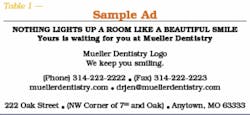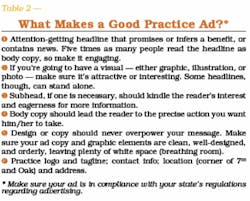Adspeak The Right Message in the rich Medium
WRITTEN BY
Sherry Weinstein, MA
After only three years in solo practice, Dr. Jennie Mueller (pseudonym) was just about ready to throw in the towel, close down her practice, and try to find a more satisfying career. It’s not that she wasn’t making a living; in fact, she was doing OK from a financial perspective. But her dream practice had turned into a sort of nightmare. Working from dawn ’til unconscious, Dr. Mueller was struggling through each day - not really enjoying the dentistry she practiced - and had no energy left for life outside the office. It was at this low time that I met Dr. Mueller at the Chicago Midwinter. She asked me to take an objective look at her marketing efforts to see if I came across any red flags. Did I ever!
“We Cater to Cowards!” shouted the headline on the first of her Yellow Pages ads. Then she proudly opened another Yellow Pages book and pointed out her ad, which bellowed, “EMERGENCIES NOW - Nights, Holidays, Weekends.” Her ad in the third of the Yellow Pages books was a bit more demure, quietly stating, “Same Day Extractions.” And finally, an attempt at humor in the fourth ad, which asked, “Are you a dental chicken?” Four separate Yellow Pages books, each with a different ad … all clichéd and all misguided.
Before discussing the merits - or more to the point, demerits - of these headlines, there’s one more that Dr. Mueller used for newspaper ads that I’d like to point out: “Got a Toothache? Give us a call.”
Now, I don’t mean to step on the toes of any doctor who has given her nod of approval to headlines like these, but I would like to call a time-out so we can take a closer look at the impact of such ads.
Self-sabotage
While these headlines may bring in their fair share of new patients, they carry some ominous baggage. For starters, both the coward and chicken headlines tend to trivialize or disparage legitimate patient fears on one hand and validate the reason for these fears on the other. Against this backdrop, patients may be embarrassed by their anxiety or hard-pressed to find fault with previous dentists who caused such fright in them. Either way, the coward and chicken concepts are not professional and send the wrong message to already skittish patients. The final blow is that such a message excludes prospective patients who are not dental cowards or chickens. Yikes!
If that’s not bad enough, the headlines referring to emergencies denigrate your professionalism, along with the importance of routine dental care and maintenance, by sanctioning and even inviting on-demand dentistry. Don’t worry, sir or ma’am, you don’t have to be a patient of record at this office … we’ll just drop everything, move our other patients aside, and take care of your emergency anytime, day or night. Got a toothache? Give us a call. We’re here to serve you whenever you may need us. Whoa, that’s some message.
What kind of patients will these double-jeopardy ads attract? It should come as no surprise that they seem to have great appeal for the low dental IQ or dentally-uneducated patient … the one who has a miserable toothache at the moment and is just looking for a quick fix, or worse yet, for some prescriptive meds to ease the pain. This type of ad will rarely attract patients who are actively seeking doctors to care for their dental health on an ongoing basis.
Dr. Mueller’s was a classic case of a high-traffic, high-anxiety practice with a nonstop flow of new patients to the office. Because most of them were one-timers, she never got to build the kind of doctor/patient relationship she would have enjoyed. What’s more, she was bitterly disappointed that her practice had become an extraction station, or at best, a drill-and-fill shop. So much for “lifetime patients” and professional satisfaction.
Change of direction
Once we identified how the practice was positioned in its advertising, as well as how that positioning impacted the doctor’s schedule and services, it was time to make some changes. Dr. Mueller recognized that her ads had led to a dead end, leaving her with a boatload of patients who dreaded going to the dentist. No matter how gentle, kind, skilled, and caring she was, most of these patients were not going to be interested in a long-term, preventive, or routine dental care arrangement. That was just not their mindset.
In our discussions, Dr. Mueller expressed a desire for more in the way of cosmetic and reconstructive dentistry, with patients who actually wanted to be in her chair. To make such a 180-degree change in direction, she would need to dig in her heels and replace inertia with initiative.
After determining her goals and discussing what makes a good practice ad, we developed an ad (Table 1) that would show the positive side of dentistry, instead of the painful or frightening aspects. Table 2 highlights our discussions.
Adspeak … watch what you say, and how
With respect to ad copy, don’t sign off on an ad that might diminish your credibility, credentials, professionalism, expertise, or experience. Be aware, too, that a bad headline isn’t the only source of potential damage an ad can do to your image. Consider the fallout from a misspelled word, like these that I’ve spotted over the years in dental practice ads in various publications: foot (root) canals or tooth clearing (cleaning) or first phase brakes (braces). Such typos are like paint splattered on an otherwise flawless canvas. It makes you look careless, so take your proofing seriously. Remember, too, that proofing isn’t only about misspellings. Just imagine your ad inadvertently running without your phone number on it, or worse, appearing with the wrong number. It’s your image, and no matter how good your marketing/advertising consultant, you need to take a proactive role in overseeing what goes into print.
Most likely places to find your ideal patient
With persuasive advertising space sales reps, it’s tough to figure out - objectively - the best place to put your ad dollars. Based on my experience with practices across the country, here’s the scoop on which venues are most and least cost-effective.
City and regional magazines ➜ Despite their soaring rates, these will give you impressive exposure and tremendous punch for your advertising budget - that is, if your goal is to attract the well-educated, well-connected, or well-heeled. Boston Magazine, for example, profiles its readers’ mean household income at $185,000 and mean net worth as $856,000. Placing your ad in this magazine - or its sister publications from coast to coast - will reach the crème de la crème, an audience of affluent readers who have both the inclination and the means to enjoy the best of your dental services.
Newsletters ➜ One of the least expensive, yet most cost-effective venues is the newsletter of a local community association, Kiwanis Club, Rotary, PTA, church/synagogue, or even the Red Hat Society. These newsletters are greeted enthusiastically and read by many members of the organization. What works particularly well in such a venue is a message of congratulations or condolence from you and your dental team to a member of the organization. In addition to recognizing the individual with a fitting tribute, the ad shows that you really know and care about your patients.
Yellow Pages ➜ Unlike city magazines and local community newsletters that allow advertisers to zero in on their “target” market, Yellow Pages are seen by the masses. As we discussed earlier, Yellow Page ads sometimes bring in large numbers of patients; however, they are often patients who have had to resort to looking in the Yellow Pages for a dentist because they may live in a setting in which nobody goes to the dentist. Typically, these will be the patients who opt to have a tooth pulled rather than trying to save it. Their value to the practice, therefore, is quite limited. Although I will not categorically state that Yellow Pages advertising does not provide a good return on investment, I’d certainly urge you to carefully weigh the costs against the revenues and type of patient generated.
A few final thoughts
• If you’re really sold on the coward or chicken concept, use something that’s not so demeaning like: “Oral Sedation” … “No Drilling, No Needles, No Noise” … or “Sleep Dentistry.”
• Don’t even consider using the old smiley-tooth icon. It has been laid to rest, along with the animated toothbrush. Although high-level humor may be used to give life to an ad, corny symbols of dentistry will never be up to the task of portraying a professional image.
• Don’t forget that when an ad using logic and one using emotion are put head to head, emotion will win out almost every time.
• Don’t get caught short. Always have a current ad on hand - either a camera-ready slick or an electronic file - for those times when you are approached by your child’s teacher on Friday for an ad journal going to print on Monday.
• Don’t allow a publication or a patient to write your ad copy. It’s true that you get what you pay for. With a wave of her/his magic wand, a good copywriter can make the difference between an awful ad and an awesome one.
• If you’re going to advertise, do it wisely. You’ll find that the harder you try, the luckier you’ll get.■
Sherry Weinstein, MA
Ms. Weinstein is president of Communication Finesse, a dental practice marketing communications firm specializing in practice brochures, ads, and identity packages. Contact her at (623) 214-5008 or [email protected].


